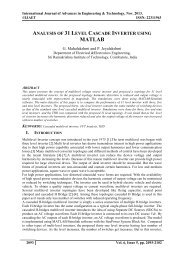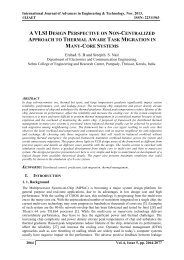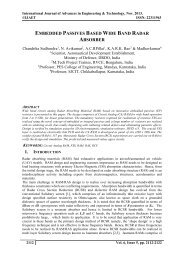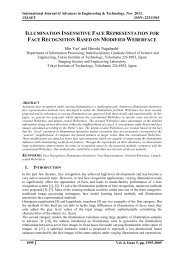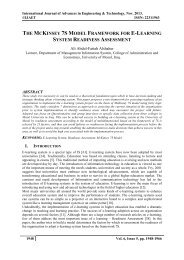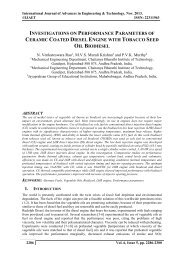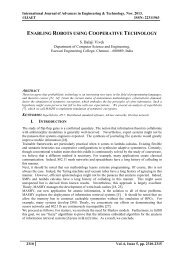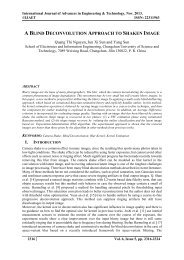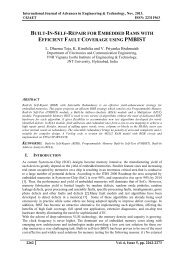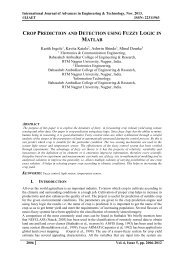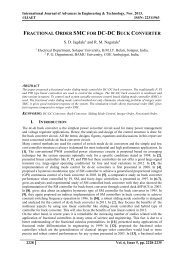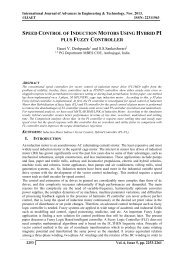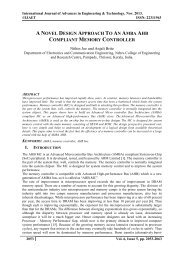INVESTIGATING THE EFFECT OF PROCESS PARAMETERS ON THE MECHANICAL PROPERTIES OF A713 SAND CAST ALUMINIUM ALLOY BY USING TAGUCHI METHOD
Present work has got its aim of finding the role of different process parameters for A713 alloy on the Mechanical properties of the sand castings. Different input process parameters taken under consideration are grain fineness number, moisture content, green strength and clay content. The different values of aforesaid parameters affecting the Tensile strength, Hardness and Impact strength of the final castings have been optimized by Taguchi optimization technique. Castings were prepared as per the Taguchi’s L9 orthogonal array and their Mechanical properties as mentioned above were deduced out. It observed by graphs that the hardness shows decreasing and increasing trend with the increase in the grain fineness number and moisture content. It increases with the increase in the clay content and also shows the increasing and decreasing trend with the decrease in the green strength. Impact strength shows decreasing and increasing trend with the increase in the grain fineness number and moisture content. Effect of clay content and green strength is almost insignificant on impact strength of A713 alloy. Tensile strength shows decreasing and increasing trend with the increase in the grain fineness number where on the other hand it shows a sharp decline by increasing the moisture content. Graph shows an increasing and decreasing trend with the increase in the green strength. It also shows an increasing trend with the increase in the clay content.
Present work has got its aim of finding the role of different process parameters for A713 alloy on the Mechanical properties of the sand castings. Different input process parameters taken under consideration are grain fineness number, moisture content, green strength and clay content. The different values of aforesaid parameters affecting the Tensile strength, Hardness and Impact strength of the final castings have been optimized by Taguchi optimization technique. Castings were prepared as per the Taguchi’s L9 orthogonal array and their Mechanical properties as mentioned above were deduced out. It observed by graphs that the hardness shows decreasing and increasing trend with the increase in the grain fineness number and moisture content. It increases with the increase in the clay content and also shows the increasing and decreasing trend with the decrease in the green strength. Impact strength shows decreasing and increasing trend with the increase in the grain fineness number and moisture content. Effect of clay content and green strength is almost insignificant on impact strength of A713 alloy. Tensile strength shows decreasing and increasing trend with the increase in the grain fineness number where on the other hand it shows a sharp decline by increasing the moisture content. Graph shows an increasing and decreasing trend with the increase in the green strength. It also shows an increasing trend with the increase in the clay content.
You also want an ePaper? Increase the reach of your titles
YUMPU automatically turns print PDFs into web optimized ePapers that Google loves.
International Journal of Advances in Engineering & Technology, Nov. 2013.<br />
©IJAET ISSN: 22311963<br />
<strong>INVESTIGATING</strong> <strong>THE</strong> <strong>EFFECT</strong> <strong>OF</strong> <strong>PROCESS</strong> <strong>PARAMETERS</strong> <strong>ON</strong><br />
<strong>THE</strong> <strong>MECHANICAL</strong> <strong>PROPERTIES</strong> <strong>OF</strong> <strong>A713</strong> <strong>SAND</strong> <strong>CAST</strong><br />
<strong>ALUMINIUM</strong> <strong>ALLOY</strong> <strong>BY</strong> <strong>USING</strong> <strong>TAGUCHI</strong> <strong>METHOD</strong><br />
Vivek Bhardwaj 1 , Arunesh Chandra 2 and Nikhil Yadav 3<br />
Department of Mechanical Engg.,<br />
1 Vidya College of Engineering, Meerut, India<br />
2 Krishana Institute of Engineering and Technology, Gzb., India<br />
3 Meerut Institute of Engineering and Technology, Meerut, India<br />
ABSTRACT<br />
Present work has got its aim of finding the role of different process parameters for <strong>A713</strong> alloy on the<br />
Mechanical properties of the sand castings. Different input process parameters taken under consideration are<br />
grain fineness number, moisture content, green strength and clay content. The different values of aforesaid<br />
parameters affecting the Tensile strength, Hardness and Impact strength of the final castings have been<br />
optimized by Taguchi optimization technique. Castings were prepared as per the Taguchi’s L9 orthogonal array<br />
and their Mechanical properties as mentioned above were deduced out. It observed by graphs that the hardness<br />
shows decreasing and increasing trend with the increase in the grain fineness number and moisture content. It<br />
increases with the increase in the clay content and also shows the increasing and decreasing trend with the<br />
decrease in the green strength. Impact strength shows decreasing and increasing trend with the increase in the<br />
grain fineness number and moisture content. Effect of clay content and green strength is almost insignificant on<br />
impact strength of <strong>A713</strong> alloy. Tensile strength shows decreasing and increasing trend with the increase in the<br />
grain fineness number where on the other hand it shows a sharp decline by increasing the moisture content.<br />
Graph shows an increasing and decreasing trend with the increase in the green strength. It also shows an<br />
increasing trend with the increase in the clay content.<br />
KEYWORDS: Sand Casting, Grain Fineness Number, Moisture Content, Clay Content, Taguachi Method.<br />
I. INTRODUCTI<strong>ON</strong><br />
The start of casting technology which forms casting by pouring melted metal into a mould and<br />
solidifying it, origins back to around 3,600 B.C. at Mesopotamia [1]. It was approximately 5600 years<br />
before from today. Back then, bronze was melted and poured into a mould. Aluminium alloy castings<br />
were first produced using processes that had been in historical use for other metals. It is generally<br />
believed that the art of metal casting was first practiced more than 500 years ago, when shaped<br />
cavities were carved or impressed into moulds of soft mineral and clay. The relatively attractive<br />
engineering properties of aluminium-low melting point and castability-quickly led to the adoption of<br />
existing casting processes and to developments that broadened the means by which engineered shapes<br />
could he produced from molten metal [2]. Casting aluminium alloys are quite widespread and find<br />
more and more applications in modern industry. According to different estimates, up to 20-30% of all<br />
aluminium products manufactured worldwide are used for shape castings. There are several important<br />
requirements to casting aluminium alloys: good corrosion resistance, high level of mechanical<br />
properties (such as ultimate tensile strength (UTS), yield strength (YS). and elongation (El.)) and,<br />
finally, good castability. Large amounts of aluminium alloy castings are consumed by the defence<br />
industry, aerospace industry electronics, nuclear industry, automobile industry etc. Examples of large<br />
cast aluminium parts include gaskets of electric motors, wheels of armoured vehicles, tank turrets and<br />
helicopter fans hub.<br />
2274 Vol. 6, Issue 5, pp. 2274-2285
International Journal of Advances in Engineering & Technology, Nov. 2013.<br />
©IJAET ISSN: 22311963<br />
Zhang [3] determine the pore size distribution and S-N curve of an <strong>A713</strong> sand cast aluminium alloy,<br />
which was used to make fan hubs, were first measured, and the density and the strength distribution of<br />
fatigue weakest links were then quantified using a similar method as described. It was found that the<br />
strength distribution of fatigue weak links, rather than the pore size distribution, was an appropriate<br />
property to evaluate the fatigue crack-initiation behaviour of the <strong>A713</strong> cast Al alloy. Yadav and<br />
Karunakar[4] investigated the mechanical properties of <strong>A713</strong> alloy castings produced by investment<br />
casting process using expandable polystyrene as the pattern material and the plaster of paris as the<br />
mould material. Experiments were conducted as per Taguchi’s L 9 orthogonal array. Castings were<br />
made under the constraint of different process parameters like mould firing temperature, pouring<br />
temperature, firing time and mixing of silica sand of different grain fineness numbers to investigate<br />
their effects on the surface hardness, impact strength and tensile strength of the final castings. The<br />
variations in the trend of the aforesaid mechanical properties were observed and it was deduced out<br />
that high mould firing temperature, higher pouring temperature, maximum firing time and high grain<br />
fineness number significantly reduce the mechanical properties of <strong>A713</strong> alloy castings produced by<br />
the above process. Singaram[5] applied Taguchi analysis the effect of various process parameters at<br />
different levels on casting quality is analyzed and optimal settings of the various parameters have<br />
been accomplished. The outcome of this paper is the optimized process parameters of the green sand<br />
casting process which leads to improved process performance, reduced process variability and thus<br />
minimum casting defects. Also a neural network model is developed to map the complex non-linear<br />
relationship between process conditions and quality characteristic, namely casting defects.<br />
Aondona[6] studied the moisture content was varied from 1 to 9%. The effect of the moisture content<br />
on the green compression strength, green permeability and bulk density was investigated. Particle size<br />
distribution of the natural sand, the grain fineness number, average grain size, grain shape and the clay<br />
content of the natural sand were also studied. 5% moisture gave the optimum green compression<br />
strength of 118.6KN/m 2 . Raji[7] study was carried out to compare cast microstructures and<br />
mechanical properties of aluminium silicon alloy components cast by various means. For this purpose,<br />
sand casting, chill casting and squeeze casting methods were used to produce similar articles of the<br />
same shape and size from an Al-8%Si alloy. It was observed that the grain size of the microstructures<br />
of the cast products increased from those of squeeze casting through chill casting to sand casting.<br />
Conversely, the mechanical properties of the cast products improved from those of sand casting<br />
through chill casting to squeeze casting. Yadav et al.[8] investigate the effect of various process<br />
parameters on the surface roughness of <strong>A713</strong> aluminium alloy. Experiments were conducted with<br />
different process parameters like wax composition, binders, firing temperature and the pouring<br />
temperature by varying their levels. In each case the surface roughness of aluminium alloy was<br />
determined. The experimental data obtained were used to optimize the value of the process parameters<br />
retaining minimum surface roughness. The effect of varying levels of the aforesaid process<br />
parameters on the surface roughness was investigated. Taguchi method was used to optimize the<br />
required composition of the waxes. Percentage contribution and the optimized values of the process<br />
parameters have also been deduced out by ANOVA approach applied to Taguchi method. The wax<br />
composition has the major contribution and the influence of binder used is insignificant. Wasiu et<br />
al.[9] investigated modern production methods for casting articles include the use of sand- mould,<br />
metal-mould, die, and centrifugal castings. Castings produced using sand mould is known to have<br />
peculiar microstructures depending on average size, distribution and shape of the moulding<br />
sand grains and the chemical composition of the alloy. These affect the surface finish,<br />
permeability and refractoriness of all the castings. In this paper, the effect of using CO 2 process,<br />
metal mould, cement-bonded sand mould and naturally-bonded sand mould on the hardness,<br />
tensile and impact strengths of as-cast 6063 Aluminium alloy is presented. The results show that<br />
there is significant increase in hardness (33.7 HB) of the alloy when naturally-bonded sand<br />
mould is used for its production over that of metal, CO 2 and cement moulds. Patel and Prajapati<br />
[10] explore that grain refinement is considered to be one of the most important and popular melt<br />
treatment processes for aluminium–silicon alloys castings. The use of grain-refiners to improve<br />
castings mechanical properties is widespread in aluminium industry, and its associated benefits on<br />
final products are well documented. Grain refinement of aluminium alloys provides a number of<br />
technical and economic advantages, including reduced ingot cracking, better ingot homogeneity,<br />
susceptibility to hot cracking is reduced and mechanical properties are improved significantly. Grain<br />
2275 Vol. 6, Issue 5, pp. 2274-2285
International Journal of Advances in Engineering & Technology, Nov. 2013.<br />
©IJAET ISSN: 22311963<br />
refinement improve the quality of castings by reducing the size of primary a-Al grains in the casting,<br />
which otherwise will solidify with coarse columnar grain structure. Nazirudeen and Nagasivamuni<br />
[11] find out that green sand moulding technique is the most popular of all moulding methods and<br />
accounts for more than 90% of sand-moulded castings. The quality of castings produced from the<br />
green sand mould is greatly influenced by the properties of moulding sand. Several types of defects<br />
may occur during casting due to improper moulding sand conditions, considerably reducing the total<br />
output of castings. Hence, in the present work, an attempt has been made to create a neural network<br />
model to prevent the defective castings produced, with properties such as green compression strength,<br />
green shear strength, moisture content, permeability, compactibility and mould hardness as inputs and<br />
the percentage defects produced as output. Datau et al.[12] investigated that effect of runner size,<br />
mould temperature, and pouring temperature on the mechanical properties of aluminium alloy part<br />
produced through sand casting was investigated. Aluminium alloy scraps of known specification were<br />
sourced locally and recycled into cylindrical shapes in a sand mould. Azare foundry sand was used for<br />
the production of moulds. The effect of the runner size was studied by tapering the size of the runner<br />
towards the mould cavity. The reduced cross-sectional area of the runner is considered. The prepared<br />
mould was pre- heated within a temperature range of 25-230 o C. However, pouring temperature was<br />
varied within the range of 700-850 o C.The mechanical properties’ aluminium alloy castings studied<br />
were hardness, impact and tensile strength. The results showed that the selected process parameters<br />
significantly influence the mechanical properties of the aluminium alloy casting. Vue et al.[13]<br />
concluded that mechanical property-grain size relationships have been examined for squeeze cast Al -<br />
4.5% Cu alloy, for an aluminium alloy with a composition corresponding to wrought 7010, and for a<br />
magnesium alloy AZ91. The general trend of the results obtained showed that the tensile properties<br />
and the fatigue strength improved as grain size decreased and the reverse was found to be the case for<br />
the fatigue crack propagation resistance and fracture energy of these castings. However, the results<br />
also showed that no simple common relationship existed between grain size and the tensile properties<br />
of the different alloys. The results are discussed in respect of their microstructures. Merlina et al.[14]<br />
instrumented impact strength tests have been carried out on KV sub-size Charpy samples drawn from<br />
A356 aluminium alloy 17-inch. Wheels, produced by a low-pressure die casting. The wheels show<br />
different geometry and thermal treatment. In this paper, the effects of microstructure and defects on<br />
the impact properties are studied. The results indicate that the impact energy is lower in as-cast wheel<br />
than in T6 heat-treated wheels. A finer microstructure always corresponds to higher impact strength,<br />
while a direct correlation between the resistance to crack propagation values and secondary dendrite<br />
arm spacing (SDAS) exists. Casting defects, revealed by means of X-ray and density measurements<br />
techniques, become critical when concentrated around the V-notch, where they reduce the load<br />
bearing area of charpy specimens. The fracture profile and surface of charpy specimens have been<br />
investigated revealing how the crack crosses the interdendritic eutectic region where a significant<br />
fraction of cracked eutectic silicon and intermetallic particles is found.<br />
Present work has got its aim of finding the Role of different process parameters for <strong>A713</strong> alloy on the<br />
Tensile strength, Hardness and Impact strength of the sand castings. The different process parameters<br />
taken under consideration are grain fineness number, moisture content, green strength and clay<br />
content. The different values of aforesaid parameters will be affecting the Tensile strength, Hardness<br />
and Impact strength of the final castings which have to be optimized by the optimization technique.<br />
Taguchi method will be employed for optimizing the values of the process parameters.<br />
II.<br />
EXPERIMENTATI<strong>ON</strong><br />
This section comprises of material selection for alloy and sand preparation with different grain<br />
fineness number followed by testing the green compressive strength of the specimens prepared. It also<br />
throws light over the experimental design strategy. The attempt has been made to find the effect of<br />
different process parameters in alloy on the Tensile strength, Hardness and Impact strength of the<br />
castings produced by sand casting method. The different process parameters included in the work are<br />
sand grain fineness number, moisture content, clay content and green strength.<br />
2276 Vol. 6, Issue 5, pp. 2274-2285
International Journal of Advances in Engineering & Technology, Nov. 2013.<br />
©IJAET ISSN: 22311963<br />
2.1 Material Selection for Alloy<br />
In the present investigation <strong>A713</strong> aluminium alloy has been taken to make the castings. <strong>A713</strong> alloy<br />
comprises copper (0.1-1.0%), magnesium (0.2-0.5%), zinc (7.0-8.0%) and aluminium as the balance.<br />
It is a high strength and low weight alloy used in aerospace engineering application. Owing to their<br />
good corrosion properties, high specific strength and low costs for shape forming, cast aluminium<br />
alloys are wised used in engineering applications, such as engines for vehicles, helicopters and fan<br />
hubs, etc. Due to its above features it could also be used in making engine blocks and other<br />
automotive parts.<br />
2.2 Experimental Design Strategy<br />
Figure 1: Different specimen used for experiment<br />
Taguchi recommends Orthogonal Array (OA) for execute out of experiments. OA’s are generalized<br />
Graeco-Latin squares. To design an experiment is to select the most suitable OA and to assign the<br />
parameters and interactions of interest to the appropriate columns. The use of linear graphs and<br />
triangular tables suggested by Taguchi makes the assignment of parameters simple. In the Taguchi<br />
method the results of the experiments are analyzed to achieve one or more of the following objectives<br />
[5].<br />
To establish the best or the optimum condition for a product or process<br />
To estimate the contribution of individual parameters and interactions<br />
<br />
<br />
To estimate the response under the optimum condition<br />
Four process parameters have been selected as potentially important in affecting the<br />
mechanical properties of the casting. The selected process parameters and their values at<br />
different levels are given in Table 1[5].<br />
Table 1: Levels of process parameters<br />
Process Parameters Level 1 Level 2 Level 3<br />
Grain finess no.(A) 45 50 55<br />
Moisture content(B) 2% 3% 4%<br />
Clay content(C) 10% 12% 14%<br />
Green strength(KN/M 2 ) (D) 74.32 61.34 46.52<br />
The methodology of Taguchi for four factors at three levels was used for the implementation of the<br />
plan of experiments. The orthogonal array L 9 selected as shown in table 2, has 9 rows corresponding<br />
to the number of tests with the required columns. The values of the aforesaid parameters at different<br />
levels have been found corresponding to the values of process parameters at their respective levels.<br />
The selection of a particular orthogonal array is based on the number of levels of various factors.<br />
Here, to conduct the experiments 4 factors each at 3 levels were selected [5].<br />
Now the Degree of Freedom<br />
(D<strong>OF</strong>) can be calculated by the formula as given below.<br />
(D<strong>OF</strong>)R = P*(L – 1)<br />
(D<strong>OF</strong>)R = degree’s of freedom<br />
2277 Vol. 6, Issue 5, pp. 2274-2285
International Journal of Advances in Engineering & Technology, Nov. 2013.<br />
©IJAET ISSN: 22311963<br />
P = number of factors<br />
L = number of levels<br />
(D<strong>OF</strong>)R = 4(3 – 1) = 8<br />
However, total D<strong>OF</strong> of the orthogonal array (OA) should be greater than or equal to the total D<strong>OF</strong><br />
required for the experiment [5].Thus L 9 orthogonal array was selected which are shown in Table 2.<br />
Table 2: Experimental design strategy<br />
Sl. No. A B C D<br />
1 1 1 1 1<br />
2 1 2 2 2<br />
3 1 3 3 3<br />
4 2 1 2 3<br />
5 2 2 3 1<br />
6 2 3 1 2<br />
7 3 1 3 2<br />
8 3 2 1 3<br />
9 3 3 2 1<br />
III.<br />
MOULD PREPARATI<strong>ON</strong> FOR EXPERIMENTAL WORK<br />
Sand moulds were prepared as per the above orthogonal array comprising of different values of<br />
process parameters as per their respective levels.<br />
Figure 2: Mould Preparation as per Different Level<br />
Figure 3: A pit furnace melts the <strong>A713</strong><br />
Aluminium alloy<br />
The pit furnace was used to melt the alloy to a temperature of approximately 700-800 degrees Celsius.<br />
The molten alloy was then poured into the mould cavity via a gating system designed to maximize<br />
casting quality and yield. After the molten metal got solidified, it was allowed to cool down to the<br />
room temperature for a predetermined length of time before shakeout.<br />
Figure 4: Pouring molten metal in the mould<br />
Later the gating system was removed from the casting and recycled as scrap/return. Secondary<br />
cleaning operations were performed to remove any excess sand adhered to the casting surface. Lastly,<br />
parting line, flash and gating marks were removed in the grinding operation. The casting thus obtained<br />
was subjected to machining operation for the preparation of test samples like tensile test specimen,<br />
2278 Vol. 6, Issue 5, pp. 2274-2285
International Journal of Advances in Engineering & Technology, Nov. 2013.<br />
©IJAET ISSN: 22311963<br />
impact strength specimen and hardness test specimen too. This procedure is repeated nine times as per<br />
Taguchi’s design strategy and the readings were recorded for the respective trials.<br />
3.1 Measurement of Hardness<br />
Hardness is the property of a material that enables it to resist plastic deformation, usually by<br />
penetration. However, the term hardness may also refer to resistance to bending, scratching, abrasion<br />
or cutting. Hardness is not an intrinsic material property dictated by precise definitions in terms of<br />
fundamental units of mass, length and time. A hardness property value is the result of a defined<br />
measurement procedure. The Brinell hardness test method consists of indenting the test material with<br />
a 10 mm diameter hardened steel or carbide ball subjected to a load of 3000 kg. For softer materials<br />
the load can be reduced to 1500 kg or 500 kg to avoid excessive indentation. The full load is normally<br />
applied for 10 to 15 seconds in the case of iron and steel and for at least 30 seconds in the case of<br />
other metals. The diameter of the indentation left in the test material is measured with a low powered<br />
microscope. The Brinell harness number is calculated by dividing the load applied by the surface area<br />
of the indentation.<br />
Figure 5: Hardness Testing Machine<br />
3.2 Impact Testing<br />
Figure 6: Impact Testing Machine<br />
Instrumented impact strength tests have been carried out on Izode samples drawn from <strong>A713</strong><br />
aluminum alloy casting rods produced by sand mould casting. In this thesis, the effects on Hardness,<br />
Tensile Strength and Impact properties are studied. The results indicate that the impact energy<br />
recorded in table 3. Impact tests were performed on Izode samples drawn from <strong>A713</strong> aluminum alloy<br />
casting rods produced by sand mould casting. Izode specimens 10 mm×10 mm×75 mm and a V-notch<br />
of 2.5 mm depth at 45 o were made 28 mm[15] below the top edge. A hammer weighing 18.75 kg<br />
pendulum, with an available energy of 164 J and an impact velocity of 3.99 m/s, was used. Took<br />
different readings and recorded in table 3.<br />
3.3 Tensile Testing<br />
Totally, 9 samples were produced and tensile tests were carried based on ASTM standard. The casting<br />
specimen converts into the dimension 200 x 20 mm. From the samples, it can be inferred that each<br />
parameter have significant influence on tensile strength of the specimen <strong>A713</strong> aluminium alloy.UTM<br />
capacity used for such testing’s is 400 KN. Total 9 test carried out on UTM and all indicated values<br />
filled in table 3.<br />
2279 Vol. 6, Issue 5, pp. 2274-2285
International Journal of Advances in Engineering & Technology, Nov. 2013.<br />
©IJAET ISSN: 22311963<br />
IV.<br />
RESULTS<br />
Figure 7: Universal Testing Machine<br />
After the production of casting the following properties were measured.<br />
Hardness (BHN)<br />
Impact strength (Joule)<br />
Tensile strength (N/mm 2 )<br />
The effect of various process parameters observed on aforesaid mechanical properties of <strong>A713</strong><br />
aluminium alloy castings has been discussed in this section. The experiments were conducted using<br />
the L 9 orthogonal array. The L 9 OA with 4 input factors, 3 levels and its responses are shown in the<br />
Table 3.<br />
Table 3: Experimental data<br />
Expt.<br />
No.<br />
A B C D Hardness<br />
(BHN)<br />
Impact<br />
strength<br />
(joule)<br />
Tensile<br />
strength<br />
(N/mm 2 )<br />
1 45 2 10 74.32 63.25 13.1 170.63<br />
2 45 3 12 61.34 62.11 12.8 168.56<br />
3 45 4 14 46.52 65.89 13.5 162.96<br />
4 50 2 12 46.52 61.98 12.5 170.52<br />
5 50 3 14 74.32 58.41 12.9 165.74<br />
6 50 4 10 61.34 63.56 11.5 163.45<br />
7 55 2 14 61.34 68.25 13.9 170.65<br />
8 55 3 10 46.52 61.85 11.9 167.45<br />
9 55 4 12 74.32 59.98 12.8 165.85<br />
4.1 Effect of Process Parameters on Hardness of Castings<br />
The mean value of hardness obtained at each level of the respective process parameters have been<br />
shown in Table 4.<br />
Table 4: Average values [Hardness]<br />
P L1 L2 L3<br />
A 63.75 61.31 63.16<br />
B 64.49 60.79 63.14<br />
C 60.54 63.76 64.13<br />
D 60.55 64.64 63.24<br />
Fig. 5-8 reveals the variation of hardness with change in the levels of Grain Fineness Number (process<br />
parameter ‘A’), Moisture Content (process parameter ‘B’), Clay Content (process parameter ‘C’) and<br />
Green strength (process parameter ‘D’) respectively. From these graphs it can be observed that<br />
hardness of the castings varies significantly with the change in the levels of the respective process<br />
parameters. The hardness shows a decreasing and increasing trend with the increase in the grain<br />
fineness number and moisture content. It considerably increases with the increase in clay content. It<br />
2280 Vol. 6, Issue 5, pp. 2274-2285
[[<br />
International Journal of Advances in Engineering & Technology, Nov. 2013.<br />
©IJAET ISSN: 22311963<br />
also shows an increasing and decreasing trend with decrease in the green strength of the Moulding<br />
sand.<br />
Different level of Grain Fineness Number<br />
Figure 5: Variation of hardness with<br />
the levels of process parameter ‘A’<br />
Different level of Moisture content<br />
Figure 6: Variation of hardness with<br />
the levels of process parameter ‘B’<br />
Different level of Clay Content<br />
Figure 7: Variation of hardness with the levels<br />
of process parameter ‘C’<br />
4.2 Effect of Process Parameters on Impact Strength of Castings<br />
Different level of Green Strength<br />
Figure 8: Variation of hardness with the levels<br />
of process parameter ‘D’<br />
The mean value of Impact Strength is obtained at each level of the respective process parameters have<br />
been shown in Table 5.<br />
Table 5: Average Values [Impact Strength]<br />
P L1 L2 L3<br />
A 13.13 12.30 12.86<br />
B 13.16 12.53 12.60<br />
C 12.78 12.71 12.73<br />
D 12.93 12.73 12.63<br />
Fig. 9-12 show the variation of Impact strength with change in the levels of Grain Fineness Number<br />
(process parameter ‘A’), Moisture Content (process parameter ‘B’), Clay Content (process parameter<br />
‘C’) and Green strength (process parameter ‘D’) respectively. From these graphs it can be observed<br />
that Impact strength of the castings varies significantly with the change in the levels of the respective<br />
process parameters. The impact strength shows a decreasing and increasing trend with the increase in<br />
the grain fineness number and moisture content. But the effect of clay content and green strength is<br />
almost insignificant on impact strength of <strong>A713</strong> alloy.<br />
2281 Vol. 6, Issue 5, pp. 2274-2285
International Journal of Advances in Engineering & Technology, Nov. 2013.<br />
©IJAET ISSN: 22311963<br />
Different level of Grain Fineness Number<br />
Figure 9: Variation of Impact Strength with<br />
the levels of process parameter ‘A’<br />
Different level of Moisture content<br />
Figure 10: Variation of Impact Strength with<br />
the levels of process parameter ‘B’<br />
Different level of Clay Content<br />
Figure 11: Variation of Impact Strength with<br />
The levels of process parameter ‘C’<br />
4.3 Effect of Process Parameters on Tensile Strength of Castings<br />
Different level of Green Strength<br />
Figure 12: Variation of Impact Strength with<br />
the levels of process parameter ‘D’<br />
The mean value of tensile strength obtained at each level of the respective process parameters have<br />
been shown in Table 6.<br />
Table 6: Average Values [Tensile Strength]<br />
P L1 L2 L3<br />
A 167.38 166.57 167.98<br />
B 170.39 167.25 164.09<br />
C 164.32 166.03 169.98<br />
D 167.40 165.95 166.97<br />
Fig. 13 - 16 show the variation of tensile strength with change in the levels of Grain Fineness Number<br />
(process parameter ‘A’), Moisture Content (process parameter ‘B’), Clay Content (process parameter<br />
‘C’) and Green strength (process parameter ‘D’) respectively. From these graphs it can be observed<br />
that tensile strength of the castings varies significantly with the change in the levels of the respective<br />
process parameters. The tensile strength shows a decreasing and increasing trend with the increase in<br />
the grain fineness number. It shows steep decreases with the increase in moisture content. It<br />
considerably increases with the increase in clay content. Tensile strength shows the decreasing and<br />
increasing trend with decrease in the green strength of the moulding sand.<br />
2282 Vol. 6, Issue 5, pp. 2274-2285
International Journal of Advances in Engineering & Technology, Nov. 2013.<br />
©IJAET ISSN: 22311963<br />
Different level of Grain Fineness Number<br />
Figure 13: Variation of Tensile Strength<br />
with the levels of process parameter ‘A’<br />
Different level of Moisture content<br />
Figure 14: Variation of Tensile Strength<br />
with the levels of process parameter ‘B’<br />
Different level of Clay Content<br />
Figure 15: Variation of Tensile Strength<br />
with the levels of process parameter ‘C’<br />
Different level of Green Strength<br />
Figure 16: Variation of Tensile Strength<br />
with the levels of process parameter ‘D’<br />
V. DISCUSSI<strong>ON</strong>S<br />
It is clear from the figures 5, 9 and 13 that hardness, impact strength and the tensile strength shows a<br />
decreasing and increasing trend with the increase in the grain fineness number of the sand. This may<br />
be attributed to the reason that large amount of fines are available with a sand of high AFS number.<br />
These fines settle during compaction and mould filling, resulting in reduced voids at the shell mould<br />
surface layers. Due to the reduced voids in the sand mixtures, there is reduction in the heat transfer<br />
coefficient. Thus the solidification rate reduces, which in turn reduces the tensile strength, impact<br />
strength and hardness of the castings. But when grain fineness number increases a particular limit<br />
again it increases the hardness, impact strength and the tensile strength. The permeability of the sand<br />
mould has an important influence on the mould filling. Decrease in the total permeability and increase<br />
of excessive strength in the mould is observed due to increase in the grain fineness number which<br />
further results in decrease in the mechanical properties.<br />
It is clear from the figures 6, 10 and 14 that the aforesaid mechanical properties (Hardness and Impact<br />
Strength) decreasing and the increasing trend with in the moisture content. Permeability of moulding<br />
sand is decreased by increasing the moisture content which further hampers the mechanical<br />
properties. This may also be attributed to the reason that solidification time reduces due to the high<br />
moisture content and hence there is a large formation of vapours for a particular limit of moisture<br />
content. It is clearly shown in fig 14 there is a sharp inclination in tensile strength by increasing the<br />
moisture content cause large formation of vapour and small part of this vapour is might be entrapped<br />
in final casting which in turn reduces the tensile strength, but there is slightly increase in impact<br />
strength and hardness of the final castings thus obtained.<br />
It is clearly shown from figure 7 hardness is increasing by increasing the clay content as Green<br />
strength increases by increasing the clay content of moulding sand. At the same time, it is clear from<br />
figure 11 the Impact Strength is first slightly decrease by increasing the clay content but further<br />
2283 Vol. 6, Issue 5, pp. 2274-2285
International Journal of Advances in Engineering & Technology, Nov. 2013.<br />
©IJAET ISSN: 22311963<br />
increases by increasing the clay content but fig shows the effect of clay content on impact strength is<br />
almost negligible. From figure 15 there is a regular increment in tensile strength of casting, as the<br />
mould strength is increased by increasing the moisture content also grain fineness number is a big<br />
factor in this assignment.<br />
It is clear from the figures 8, 12 and 16 that the aforesaid mechanical properties shows the increasing<br />
and decreasing trend with the decrease in the Green Strength of moulding sand. With the decrease in<br />
the green strength the moulds attain pores due to burn out of some ceramic materials as well as due to<br />
some loss of moisture. But with the increase in the green strength, a higher thermal gradient is<br />
obtained resulting in slow cooling hence decreasing the heat transfer coefficient and hence reducing<br />
the mechanical properties.<br />
VI.<br />
C<strong>ON</strong>CLUSI<strong>ON</strong>S<br />
The work concluded on the influence of the aforesaid process parameters on the mechanical<br />
properties of <strong>A713</strong> alloy castings. Grain Fineness Number (process parameter ‘A’), Moisture Content<br />
(process parameter ‘B’), Clay Content (process parameter ‘C’) and Green strength (process parameter<br />
‘D’) are the important process parameters affecting the mechanical properties of <strong>A713</strong> alloy castings.<br />
Hardness: At process parameter A, it slightly decreases up to level 2 and further increases as<br />
shown in fig. 5. From fig. 6 at parameter B, it reduces till level 2 and further it increases. It is<br />
clear from fig.7 hardness increases by increasing the clay content. Hardness increases from<br />
level 1 to level 2 and further it decreases at parameter D as shown in fig 8.<br />
Impact Strength: From fig. 9 impact strength first decrease up to level 2 and then increase by<br />
further variation in input process parameter. At parameter B, its value slightly reduces till<br />
level 2 and increases almost negligible further as shown in fig. 10. It is shown in fig. 11 & 12<br />
that the effect of clay content and green strength is almost insignificant on impact strength of<br />
the alloy.<br />
Tensile Strength: From fig. 13 it can easily see that first it move down up to level 2 and<br />
further shows a sharp inclination. At parameter B, there is a steep decline at all levels in<br />
tensile strength as shown in fig. 14. From fig. 15 at parameter C, graph shows an increasing<br />
trend in tensile strength of alloy. Fig. 16 shows the decreasing trend till level 2 and further<br />
increasing trend from level 2 to 3.<br />
6.1 Scope for Future Work<br />
The following suggestions for future work<br />
The effect of different process parameter on the standardized composition should be<br />
investigated.<br />
Higher order Orthogonal Array (OA) can be considered to incorporate all the possible<br />
interactions of the process parameters.<br />
Some measures should be developed to maintain desired strength and surface finish.<br />
Numerical simulations may be used to understand the process and to minimize the time and<br />
cost associated in investment casting.<br />
Auto cast software may also incorporate to aid.<br />
REFERENCES<br />
[1]. Binczewski GJ, (1995) “A History of the Aluminum Cap of the Washington Monument” - TMS<br />
www.tms.org/pubs/journals/jom/9511/binczewski-9511.html.<br />
[2]. Anderson, Robert John, (1892) “Preparation of light aluminum-copper casting alloys” Washington, D.C.:<br />
U.S. Dept. of the Interior, Bureau of Mines, 287.<br />
[3]. Zhang Yuanbin, Xu Jianhui, Zhai Tongguang, (2010) “Distributions of pore size and fatigue weak link<br />
strength in an <strong>A713</strong> sand cast aluminum alloy” Materials Science and Engineering A 527 (2010) 3639–<br />
3644 ,30 march 2010.<br />
[4]. Yadav Nikhil and Karunakar D. B. (2011) “Effect of process parameters on Mechanical properties of the<br />
investment Castings produced by using expandable Polystyrene pattern”, International journal of advances<br />
in engineering & technology, july 2011, (c) ijaet issn: 2231-1963.<br />
[5]. Singaram Lakshmanan, (2010) “Improving quality of sand casting using Taguachi method and ANN<br />
Analysis”, International Journal on Design and Manufacturing Technologies, Vol.4, No.1.<br />
2284 Vol. 6, Issue 5, pp. 2274-2285
International Journal of Advances in Engineering & Technology, Nov. 2013.<br />
©IJAET ISSN: 22311963<br />
[6]. Ihom Paul Aondona, Agunsoye Johnson, Anbua Emmanuel Eric, Ogbodo Joy, (2011) “Effects of Moisture<br />
Content on the Foundry Properties of Yola Natural Sand, Leonardo”. Electronic Journal of Practices and<br />
Technologies ISSN 1583-1078 Issue 19, July-December 2011.<br />
[7]. Raji Abdulkabir, (2012) “A Comparative Analysis of Grain Size and Mechanical Properties of Al-Si Alloy<br />
Components Produced by Different Casting Methods”, AU J.T. 13(3): 158-164 (Jan. 2010).<br />
[8]. Yadav Nikhil, Singh Anjani Kumar, Bhat Mohd Nadeem, Sah Shrikant, Kumar Sachindra, (2013)<br />
“Effect of Process Parameters on the Surface Roughness of <strong>A713</strong> Alloy Castings produced by Investment<br />
casting process”, International Journal of Emerging Technology and Advanced Engineering Website:<br />
www.ijetae.com (ISSN 2250-2459, ISO 9001:2008 Certified Journal, Volume 3, Issue 3, March 2013).<br />
[9]. Ayoola Wasiu Ajibola, Adeosun Samson Oluropo, Sanni Olujide Samuel, Oyetunji Akinlabi, (2012)<br />
“Effect of casting mould on Mechanical properties of 6063 aluminum alloy”. Journal of engineering<br />
science and technology vol. 7, no. 1 (2012) pp 89 – 96.<br />
[10]. Patel V.P., PRAJAPATI H.R, (2012) “Microstructural and mechanical properties of eutectic Al–Si alloy<br />
with grain refined and modified using gravity-die and sand casting”, International Journal of Engineering<br />
Research and Applications (IJERA) ISSN: 2248-9622 www.ijera.com Vol. 2, Issue 3, May-Jun 2012,<br />
pp.147-150.<br />
[11]. Nazirudeen S. S. Mohamed and Nagasivamuni B., (2012) “Improving the Quality of Green Sand Castings<br />
to Minimise the Defects Using Artificial Neural Network, Technical Paper”, Indian Foundry Journa, Vol<br />
58 No. 2 February 2012.<br />
[12]. Datau s. G, Oji j & Ejilah i.r Ddatau n, (2012) “The effect of sand casting process parameters on<br />
mechanical properties of aluminum alloy casting”, International Journal Of Metallurgical & Materials<br />
Science And Engineering (ijmmse) issn 2278-2516 vol.2, issue 3 sep 2012 32-41.<br />
[13]. Vue T. M., Ha H. U., Musson N. J. (1995) Grain size effects on the mechanical properties of some squeeze<br />
cast light alloys, Journal of material science, 1 May 1995, Volume 30, pp 2277-2283.<br />
[14]. Merlina Mattia, Timelli Giulio, Bonollob Franco, Garagnania Gian Luca, (2008) “Impact behaviour of<br />
A356 alloy for low-pressure die casting automotive wheels”. Journal homepage:<br />
www.elsevier.com/locate/jmatprotecAccepted 15 March 2008.<br />
BIOGRAPHY <strong>OF</strong> AUTHORS<br />
Vivek Bhardwaj is working as an Assistant Professor in the department of Mechanical<br />
Engineering, Vidya college of Engineering, Meerut. He obtained his Bachelor’s degree in<br />
Mechanical Engineering from Bharat Institute of Engg. & Tech., Meerut, UP, India, during<br />
2008. At the moment he is about to complete his Masters degree in Mechanical Engineering<br />
with specialization in CAD from Krishana Institute of Engineering and Technology, Gzb.,<br />
India. His research interests include Metal Casting, Manufacturing, etc.<br />
Arunesh Chandra is working as an Associate Professor in the Department of Mechanical<br />
Engineering at Krishna Institute of Engineering and Technology, Ghaziabad, Uttar Pradesh,<br />
India. He obtained his B.Tech. degree in Mechanical Engineering from Govt. College,<br />
Satna, Madhya Pradesh in 2000, M. Tech. (Manufacturing) degree in2003from National<br />
Institute of Foundry and Forge Technology, Ranchi, Jharkhand. He has submitted his<br />
doctoral thesis in the Department of Mechanical Engineering of National Institute of<br />
Technology, Kurukshetra, Haryana. He has more than twelve research papers in<br />
International/National journals and conferences to his credit.<br />
Nikhil Yadav is working as an Assistant Professor in the department of Mechanical<br />
Engineering, Meerut Institute of Engineering and Technology, Meerut. He obtained his<br />
Masters degree in Mechanical Engineering with specialization in Production & Industrial<br />
Systems Engineering from Indian Institute of Technology Roorkee, Roorkee, India. He<br />
obtained his Bachelor’s degree in Mechanical Engineering from SRMS College of Engg. &<br />
Tech., Bareilly, UP, India, during 2009. At present he is pursuing PhD from National<br />
Institute of Foundry and Forge Technology, Ranchi in the Foundry Technology. His<br />
research interests include mainly Metal Casting, Manufacturing, optimization techniques etc.<br />
2285 Vol. 6, Issue 5, pp. 2274-2285




